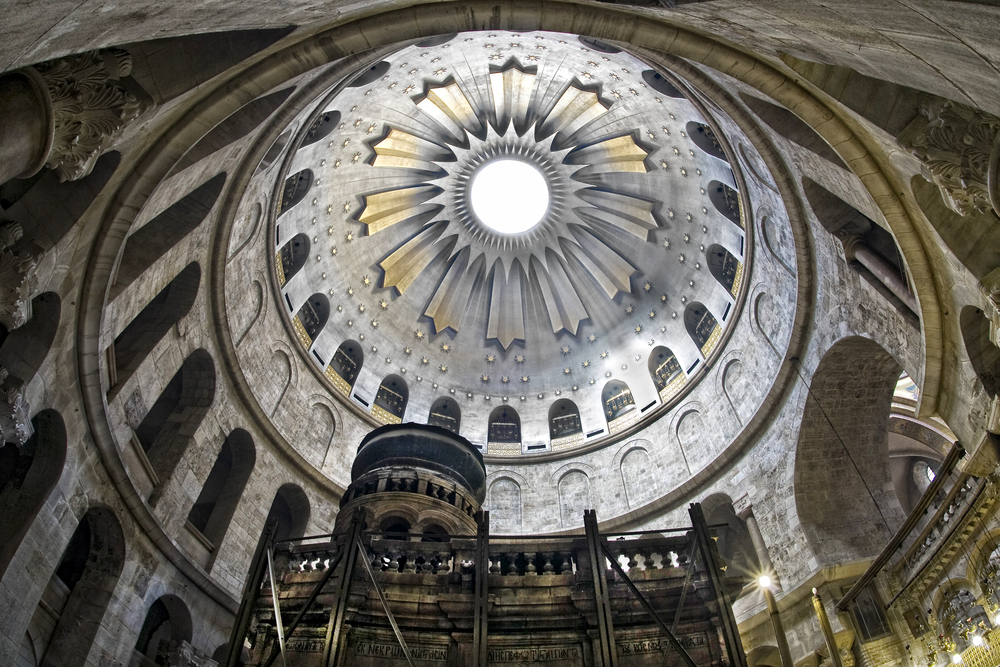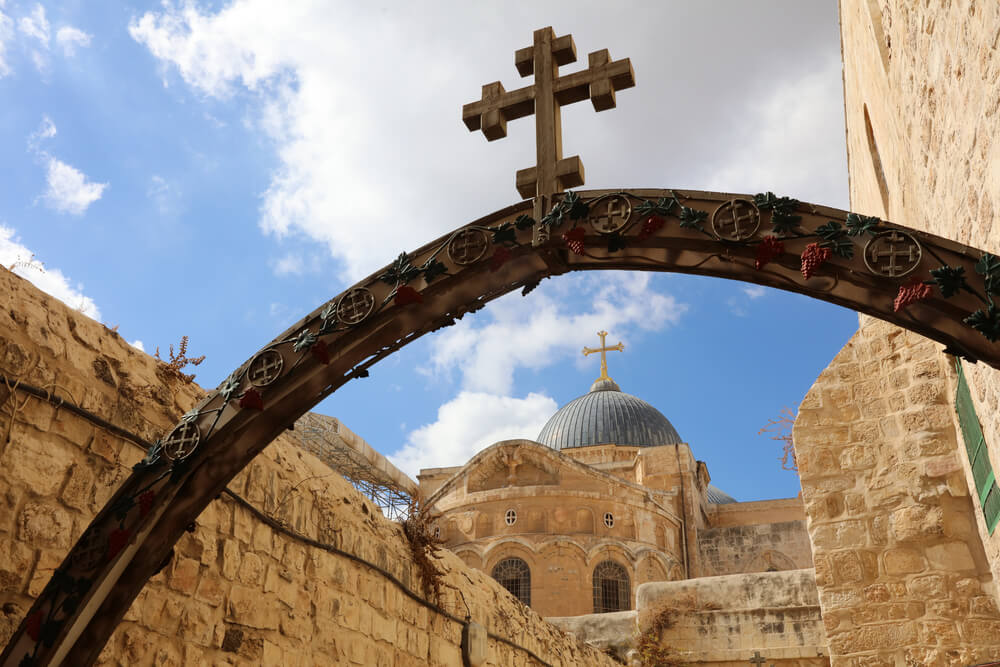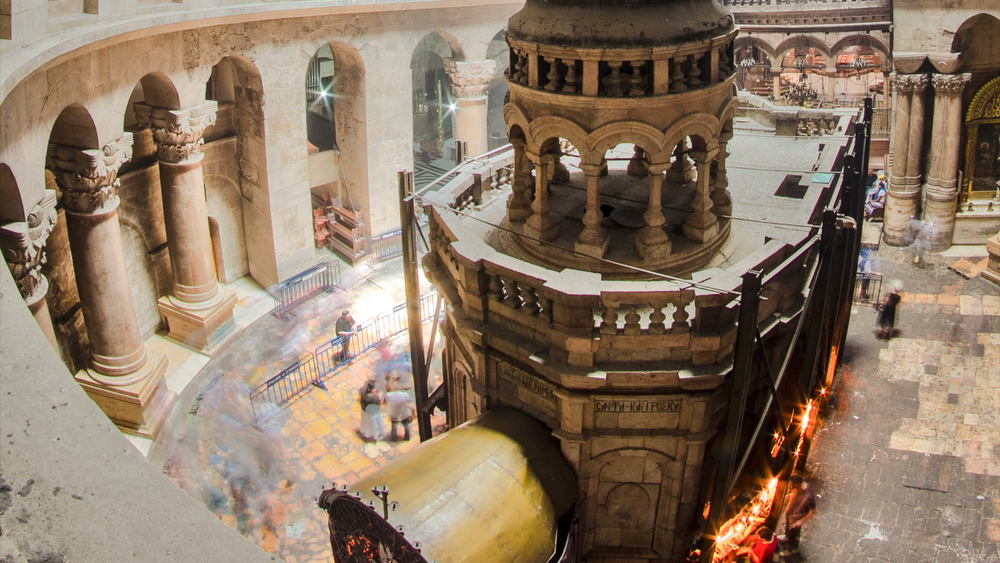 Inside the Church of the Holy Sepulchre
Inside the Church of the Holy Sepulchre
If you have time to visit only one church in Israel this should be the one! The Church of the Holy Sepulchre (or Sepulcher, Church of the Anastasia, Church of the Resurrection) is not only the most sacred Christian site, but it is also a magnificent structure with a rich and complex history.
You don’t need to buy a ticket or schedule a visit to the Holy Sepulchre. It is a functioning church where devoted Christians of all denominations come to pray. However the church is in the heart of the Old City, so if you are nervous about getting lost, or taking the wrong turn down one of the narrow lanes, then perhaps join an Old City guided tour.
 Walking down Via Dolorosa on the way to the Church of the Holy Sepulchre
Walking down Via Dolorosa on the way to the Church of the Holy Sepulchre
You can reach the Holy Sepulcher Church by following the Via Dolorosa, the route through the Old City taken by Jesus as he carried his cross to Calvary. Along the Via Dolorosa, you’ll encounter the Stations of the Cross (marking points where Jesus stopped along his route).
At the 9th Station (the last one before entering the Holy Sepulchre) go into the small chapel and you can go down a few stone steps to a 2000-year-old water pool.
At the end of the Via Dolorosa is the church. The last five Stations of the Cross are within the church.
Pro Tip: If you are on a guided tour of Jerusalem they will take you onto the roof of the church and down through a fascinating Ethiopian Monastery.
The site of the church was sacred long before the church was built. Back in about 33 AD, the place where the church stands today was outside the city walls. And this is where Jesus was taken to a hill called Calvary or Golgotha to be crucified. He was then laid to rest in a nearby cave, the Tomb of Christ, and from here Jesus was resurrected. Sepulcher means tomb.
 Church of the Holy Sepulchre
Church of the Holy Sepulchre
And so, about 300 years later in 325-6 AD when the mother of Christian Roman Emperor Constantine traveled to the Holy Land to locate biblical sites, she came to what was believed to be the place of Christ’s crucifixion, burial, and resurrection.
The Emperor’s mother, Helena identified the sacred sites where a temple to the deity Aphrodite had been built by Emperor Hadrian. The land was acquired to build a church to encompass the tomb, the last five Stations of the Cross, and the Calvary.
The huge opulent church has been destroyed and rebuilt several times over the last 1700 years and what we see today dates back mainly to the 12th-century Crusaders.
The church is controlled by six Christian denominations, which all need to agree on any renovations or changes to the structure. It has not always been a peaceful collaboration, and when they disagree, things simply don’t get done.
Pro Tip: As you stand in front of the main entrance, look up and you will see a small wooden ladder on a ledge under a window. It has been called the immovable ladder and has been there since 1728, apparently because the controlling Christian denominations couldn’t agree, and didn’t want to disturb the status quo. To ensure the neutrality of the Holy Sepulchre, the keys to the church are in the hands of a local Muslim family.
You don’t need an agenda when visiting the church, the best way to see it is to walk around soaking up the atmosphere and discovering hidden gems. It is a massive structure covering more than 5000m² so take your time. A classic walk through the church will take you from Calvary (immediately on your right as you enter the church), to the Tomb of Christ with a stop at the Stone of Unction. After seeing Calvary return to the entrance and start moving clockwise around the church.
 Inside the Church
Inside the Church
Pro Tip: One of the church’s hidden gems is the Chapel of Helena. Go past the Chapel of the Derision, and you’ll see a flight of stairs leading down into the chapel. It is located in a 4th-century crypt and owned by the Armenian Church. This is the oldest complete part of the church and one of the church’s two underground chapels. From the chapel, you can access the place where Helena discovered the “True Cross” of Jesus. There is a lot to see, and it can be overwhelming, but here are the essentials.
As you enter the church look to your right and you’ll see a small flight of stairs going up to Calvary (to the top of what was once a hill). Today it is a chapel (Greek and Catholic).
Immediately in front of you as you enter the church is the Stone of Anointing (or Stone of Unction). You’ll recognize it by the oil lamps suspended above it and the multitude of people on their knees kissing the stone. It is believed to have been the stone where Jesus’ body was laid before burial.
The Rotunda is a huge, circular area in the church with a highly decorated ceiling. The center of the ceiling is open to the sky where light beams down onto the Aedicule. The Aedicule is the chapel where Christ’s Tomb is located. The tomb itself is surprisingly big, And if the church is holy, then the tomb is the holy of holies.
Pro Tip: Visiting the Tomb of Christ is in high demand and you will often have to wait in line. A guardian stands at the entrance and lets people enter for just a few seconds.
Tours You May Like